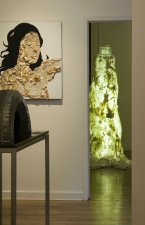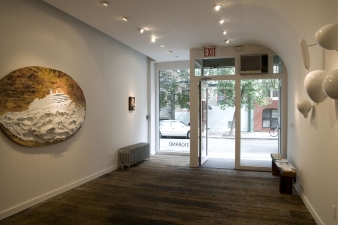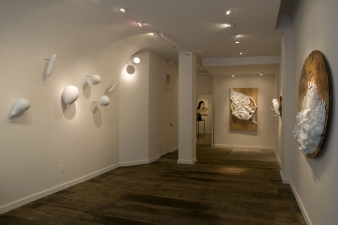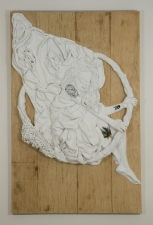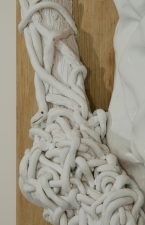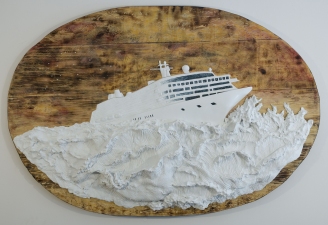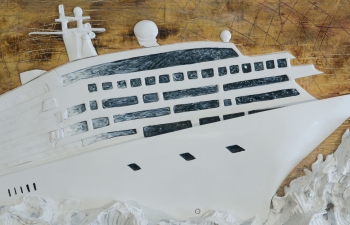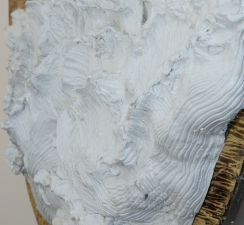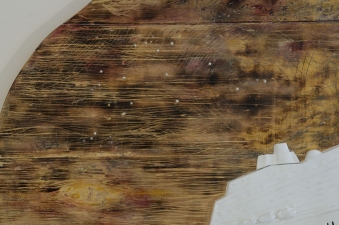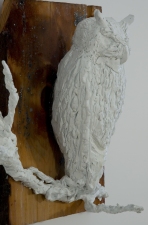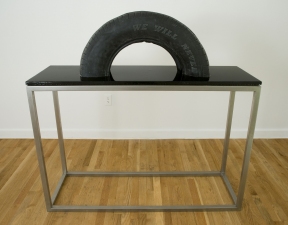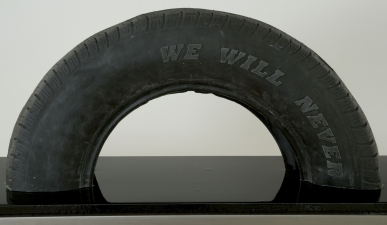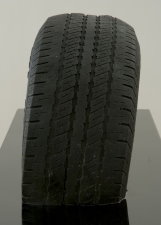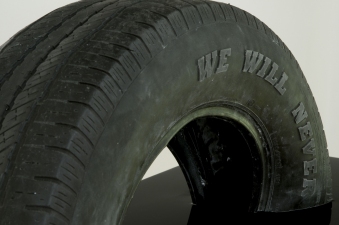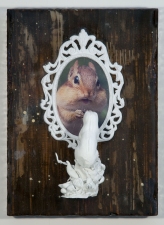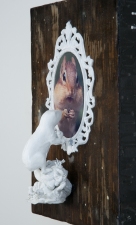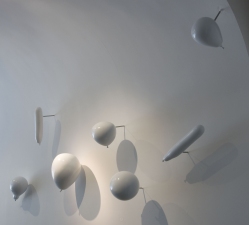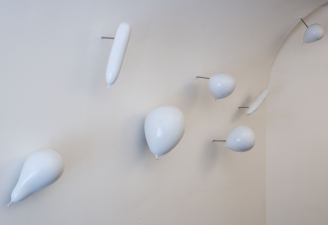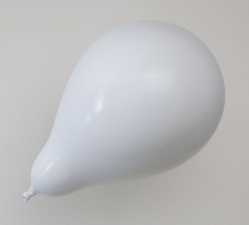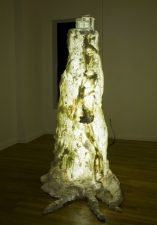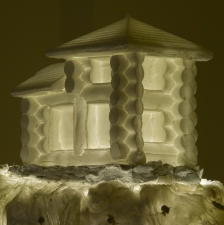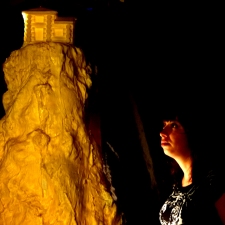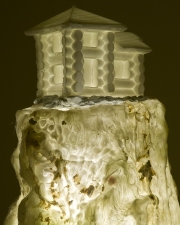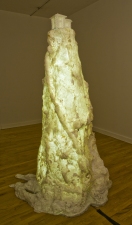SHINY BRIGHT SOUVENIR
31GRAND is pleased to present SHINY BRIGHT SOUVENIR. Roughly based on Thomas Cole’s Voyage of Life painting series and 18th century Romanticism, SHINY BRIGHT SOUVENIR is a nautical passageway from the past, both in an art historical context and from feelings and expectations associated with the romantic period. Cole’s Voyage of Life (1840) series of paintings is the allegorical story of a voyager who travels in a boat on the river of life. Accompanied by a guardian angel, an infant appears from a dark cave; as a youth the boy sees a shining castle in the sky; in manhood he relies on faith and strength to sustain him through torrential rough waters and sublime landscapes to have the angel guide him to eternity. This combination of the sublime with religious, philosophical, and contemporary socio-political themes is prevalent in Gurecka’s SHINY BRIGHT SOUVENIR.
Souvenirs and tchotchkes represent history; brought home by the traveler, these knick-knacks and keepsakes function as physical manifestations of the memories associated with the journey. Likewise, history itself is a souvenir of the past that, due to the winner’s hegemonic reconceptualization of “history,” is glamorized and glossed over by indulgent radiance in the present. Gurecka finds humor and absurdity in how easily memory devolves into nostalgia, which in turn degrades into consumerism. For Gurecka, the souvenir is a hopeless projection and a representation of fear; in this, his vision accords with Nietzsche’s description of nostalgia as the longing for the past, the contempt for the present, and the fear of the future.
The Hudson River School painters of the first half of the 19th century brought the idea of the sublime to plastic arts while maintaining an emphasis on the picturesque. Gurecka celebrates the romantic ideals of the Hudson River school, accentuating the idea of the sublime and attending to Victor Hugo’s theories of how artists and authors create the sublime through art. The active, rational viewer is able to experience emotions such as trepidation, horror, and awe in the sublime,
“The Voyage of the Crystal Symphony” shows the Crystal Symphony cruise ship retreating from the constellation Aquarius at its rear and entering the eye of a fantastic, sublime storm. Immanuel Kant talks about the sublime and how the safest way to the sublime is through the idea of the subsidiary venues, which for the contemporary traveler translates into our present day cruise lines, amusement parks, casinos, and video games. This notion of absolute greatness with neither limits nor constraints can create fearfulness, but at the same time also ultimately create a pleasurable experience.
In the wall relief, “Sleeper,” a siren floats along on a similar journey. Romanticism was loaded with mythic stories of the mystic relationships between men, women, and water. In their desperate loneliness, seamen believed that lighthouses were kept by sirens, who lived on rocky islands where they lured ships to their destruction. Fittingly, the goddess of beauty herself, Venus, was born of vengeance: the severed genitals of Uranus, who was castrated by his son, Cronus, fell into the sea and fertilized the water from which Venus arose. “Sleeper” references this grisly conception as well as Sandro Boticelli’s iconic imagining of the Birth of Venus in the Uffizi and Franz Kafka’s assertion, in the Silence of Sirens, that a siren’s silence is more fatal than her song. As an amalgamation of beauty and destructiveness, perhaps the danger of Gurecka’s siren is her somnolent, latent wrath.
In the illuminated sculpture, “My Fathers House,” biblical, mythological and personal attributes contrasted with the artist’s personal journey. The softly illuminated cast Lincoln log house atop a rough, sinewy, trunk-like pedestal is both welcoming and subtly menacing. Here Gurecka melds the iconographically powerful image of the lighthouse—with its references to solitude, the sea, sirens, and the Christian symbol of divine guidance—with the struggle for autonomy in a personal homage to his birth father and their struggles for individuality. Though the strong control that religion has even on a non-practicing person is inescapable, this dramatic vision of the world and salvation can only truly service the artistic dramatization of life and pursuit.
Personal memory flattens into a collective and anonymous past: consumer culture takes advantage of a lack of awareness through mythologizing and fetishizing experience. In Gurecka’s cast sculpture of an SUV tire sinking into the gallery floor (“We Will Never”), this type of patriotic consumerism creates a falsely empathetic slogan. Here again, memorabilia is valued for its connection to a historical event—at its worst, it is at its best.
In past work, Gurecka relied on the organic material and its relevance to the idea, a heterogeneous entity where the material was actually the host to the idea. In much the same way, Gurecka now deals with a very organic material in our natural world: plastic. Gurecka emphasizes the obvious and absurdity in the question, “What is nature?” Arguably, what once was nature/natural persists in the contemporary world, equally present in the dyad of city and country or in the contrived in-between; the simulacrum of suburbia is as manifestly “real” as other experiences. “When I visit my home in the country, all I see is nature being faked out by plastic commodities, birdhouses, house banners, above ground pools when a pond is nearby, and to think they believe they live in nature…”
31GRAND is pleased to present SHINY BRIGHT SOUVENIR. Roughly based on Thomas Cole’s Voyage of Life painting series and 18th century Romanticism, SHINY BRIGHT SOUVENIR is a nautical passageway from the past, both in an art historical context and from feelings and expectations associated with the romantic period. Cole’s Voyage of Life (1840) series of paintings is the allegorical story of a voyager who travels in a boat on the river of life. Accompanied by a guardian angel, an infant appears from a dark cave; as a youth the boy sees a shining castle in the sky; in manhood he relies on faith and strength to sustain him through torrential rough waters and sublime landscapes to have the angel guide him to eternity. This combination of the sublime with religious, philosophical, and contemporary socio-political themes is prevalent in Gurecka’s SHINY BRIGHT SOUVENIR.
Souvenirs and tchotchkes represent history; brought home by the traveler, these knick-knacks and keepsakes function as physical manifestations of the memories associated with the journey. Likewise, history itself is a souvenir of the past that, due to the winner’s hegemonic reconceptualization of “history,” is glamorized and glossed over by indulgent radiance in the present. Gurecka finds humor and absurdity in how easily memory devolves into nostalgia, which in turn degrades into consumerism. For Gurecka, the souvenir is a hopeless projection and a representation of fear; in this, his vision accords with Nietzsche’s description of nostalgia as the longing for the past, the contempt for the present, and the fear of the future.
The Hudson River School painters of the first half of the 19th century brought the idea of the sublime to plastic arts while maintaining an emphasis on the picturesque. Gurecka celebrates the romantic ideals of the Hudson River school, accentuating the idea of the sublime and attending to Victor Hugo’s theories of how artists and authors create the sublime through art. The active, rational viewer is able to experience emotions such as trepidation, horror, and awe in the sublime,
“The Voyage of the Crystal Symphony” shows the Crystal Symphony cruise ship retreating from the constellation Aquarius at its rear and entering the eye of a fantastic, sublime storm. Immanuel Kant talks about the sublime and how the safest way to the sublime is through the idea of the subsidiary venues, which for the contemporary traveler translates into our present day cruise lines, amusement parks, casinos, and video games. This notion of absolute greatness with neither limits nor constraints can create fearfulness, but at the same time also ultimately create a pleasurable experience.
In the wall relief, “Sleeper,” a siren floats along on a similar journey. Romanticism was loaded with mythic stories of the mystic relationships between men, women, and water. In their desperate loneliness, seamen believed that lighthouses were kept by sirens, who lived on rocky islands where they lured ships to their destruction. Fittingly, the goddess of beauty herself, Venus, was born of vengeance: the severed genitals of Uranus, who was castrated by his son, Cronus, fell into the sea and fertilized the water from which Venus arose. “Sleeper” references this grisly conception as well as Sandro Boticelli’s iconic imagining of the Birth of Venus in the Uffizi and Franz Kafka’s assertion, in the Silence of Sirens, that a siren’s silence is more fatal than her song. As an amalgamation of beauty and destructiveness, perhaps the danger of Gurecka’s siren is her somnolent, latent wrath.
In the illuminated sculpture, “My Fathers House,” biblical, mythological and personal attributes contrasted with the artist’s personal journey. The softly illuminated cast Lincoln log house atop a rough, sinewy, trunk-like pedestal is both welcoming and subtly menacing. Here Gurecka melds the iconographically powerful image of the lighthouse—with its references to solitude, the sea, sirens, and the Christian symbol of divine guidance—with the struggle for autonomy in a personal homage to his birth father and their struggles for individuality. Though the strong control that religion has even on a non-practicing person is inescapable, this dramatic vision of the world and salvation can only truly service the artistic dramatization of life and pursuit.
Personal memory flattens into a collective and anonymous past: consumer culture takes advantage of a lack of awareness through mythologizing and fetishizing experience. In Gurecka’s cast sculpture of an SUV tire sinking into the gallery floor (“We Will Never”), this type of patriotic consumerism creates a falsely empathetic slogan. Here again, memorabilia is valued for its connection to a historical event—at its worst, it is at its best.
In past work, Gurecka relied on the organic material and its relevance to the idea, a heterogeneous entity where the material was actually the host to the idea. In much the same way, Gurecka now deals with a very organic material in our natural world: plastic. Gurecka emphasizes the obvious and absurdity in the question, “What is nature?” Arguably, what once was nature/natural persists in the contemporary world, equally present in the dyad of city and country or in the contrived in-between; the simulacrum of suburbia is as manifestly “real” as other experiences. “When I visit my home in the country, all I see is nature being faked out by plastic commodities, birdhouses, house banners, above ground pools when a pond is nearby, and to think they believe they live in nature…”
solo exhibition, "Shiny Bright Souvenir", 2008 31Grand Gallery, New York, NY.
The Sleeper
2008
cast salt, resin, automotive enamel, boat wax, mounted on faux distressed wood panel.
63" X 41X 8"
2008
cast salt, resin, automotive enamel, boat wax, mounted on faux distressed wood panel.
63" X 41X 8"
a siren floats along on a similar journey. Romanticism was loaded with mythic stories of the mystic relationships between men, women, and water. In their desperate loneliness, seamen believed that lighthouses were kept by sirens, who lived on rocky islands where they lured ships to their destruction. Fittingly, the goddess of beauty herself, Venus, was born of vengeance: the severed genitals of Uranus, who was castrated by his son, Cronus, fell into the sea and fertilized the water from which Venus arose. “Sleeper” references this grisly conception as well as Sandro Boticelli’s iconic imagining of the Birth of Venus in the Uffizi and Franz Kafka’s assertion, in the Silence of Sirens, that a siren’s silence is more fatal than her song. As an amalgamation of beauty and destructiveness, perhaps the danger of Gurecka’s siren is her somnolent, latent wrath.
The Voyage of the Crystal Symphony (Between the Devil and the Deep Blue Sea)
2008
cast salt, resin, automotive enamel pearls, boat wax, mounted on faux distressed wood panel.
4" X 6 X 10"
2008
cast salt, resin, automotive enamel pearls, boat wax, mounted on faux distressed wood panel.
4" X 6 X 10"
“The Voyage of the Crystal Symphony” is the juxtoposion of a modern day cruise line placed within a; British ship at storm painting. It presents the Crystal Symphony cruise ship retreating from the constellation Aquarius at its rear and entering the eye of a fantastic, sublime storm. Immanuel Kant talks about the sublime and how the safest way to the sublime is through the idea of the subsidiary venues, which for the contemporary traveler translates into our present day cruise lines, amusement parks, casinos, and video games. This notion of absolute greatness with neither limits nor constraints can create fearfulness, but at the same time also ultimately create a pleasurable experience.
We Will Never
2008
cast resin tire, metal, hardware, mounted on poured resin panel
5' X 36" X 13"
2008
cast resin tire, metal, hardware, mounted on poured resin panel
5' X 36" X 13"
"We Will Never " is a plastic cast(resin) of a real blown out SUV tire that was found on the underpass of the Brooklyn Queens Expressway. I applied the white raised letters which read- We Will Never, to reference our patriotic slogan for the 911 attacks.
Personal memory flattens into a collective and anonymous past: consumer culture takes advantage of a lack of awareness through mythologizing and fetishizing experience. In Gurecka’s cast sculpture of an SUV tire sinking into the gallery floor (“We Will Never”), this type of patriotic consumerism creates a falsely empathetic slogan. Here again, memorabilia is valued for its connection to a historical event—at its worst, it is at its best.
Personal memory flattens into a collective and anonymous past: consumer culture takes advantage of a lack of awareness through mythologizing and fetishizing experience. In Gurecka’s cast sculpture of an SUV tire sinking into the gallery floor (“We Will Never”), this type of patriotic consumerism creates a falsely empathetic slogan. Here again, memorabilia is valued for its connection to a historical event—at its worst, it is at its best.
My Fathers House
2008
hand molded and cast resin, interior lighting
75" X 36 X 42
2008
hand molded and cast resin, interior lighting
75" X 36 X 42
In the illuminated sculpture, “My Fathers House,” biblical, mythological and personal attributes contrasted with the artist’s personal journey. The softly illuminated cast Lincoln log house atop a rough, sinewy, trunk-like pedestal is both welcoming and subtly menacing. Here Gurecka melds the iconographically powerful image of the lighthouse—with its references to solitude, the sea, sirens, and the Christian symbol of divine guidance—with the struggle for autonomy in a personal homage to his birth father and their struggles for individuality. Though the strong control that religion has even on a non-practicing person is inescapable, this dramatic vision of the world and salvation can only truly service the artistic dramatization of life and pursuit.



